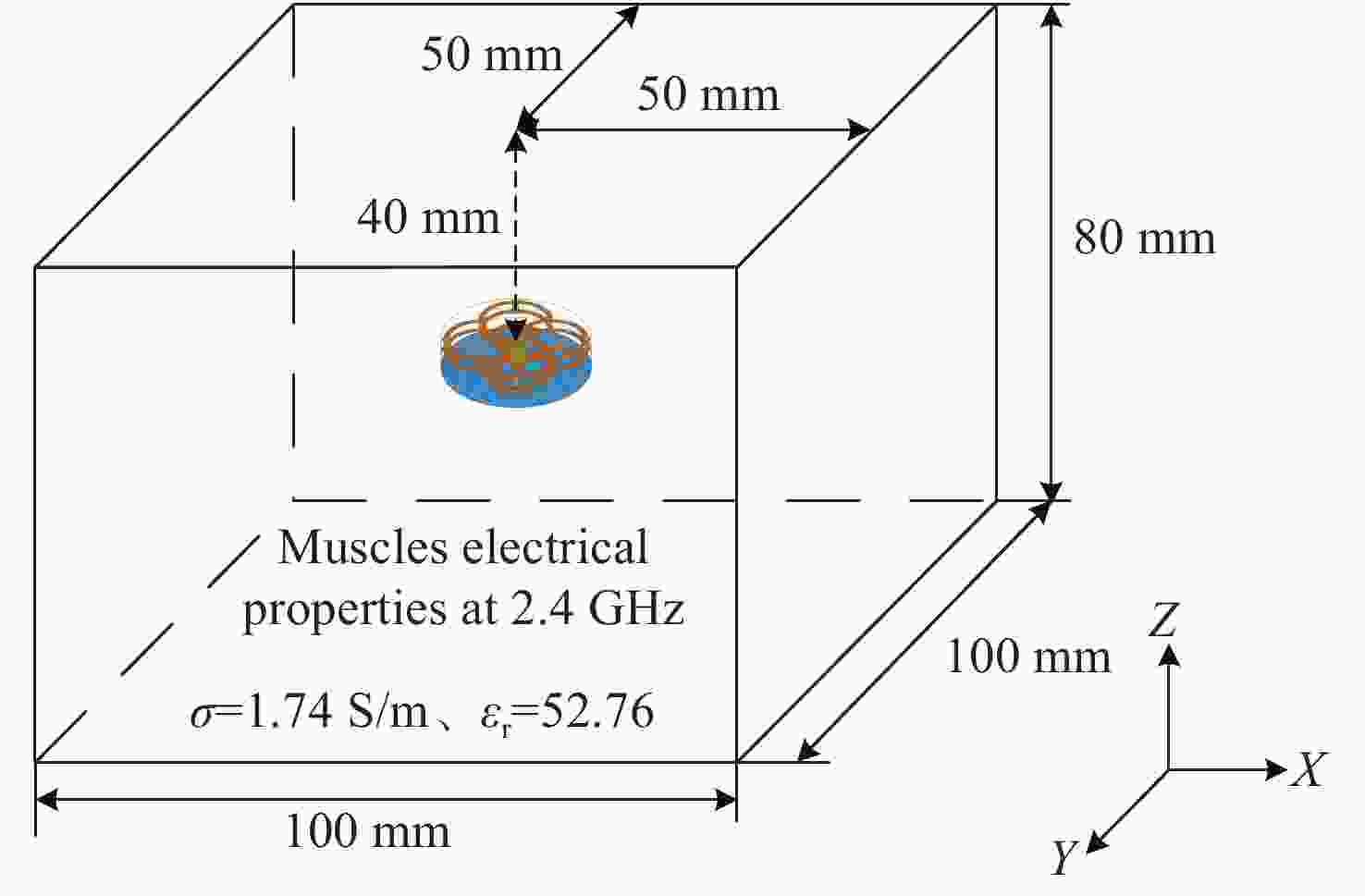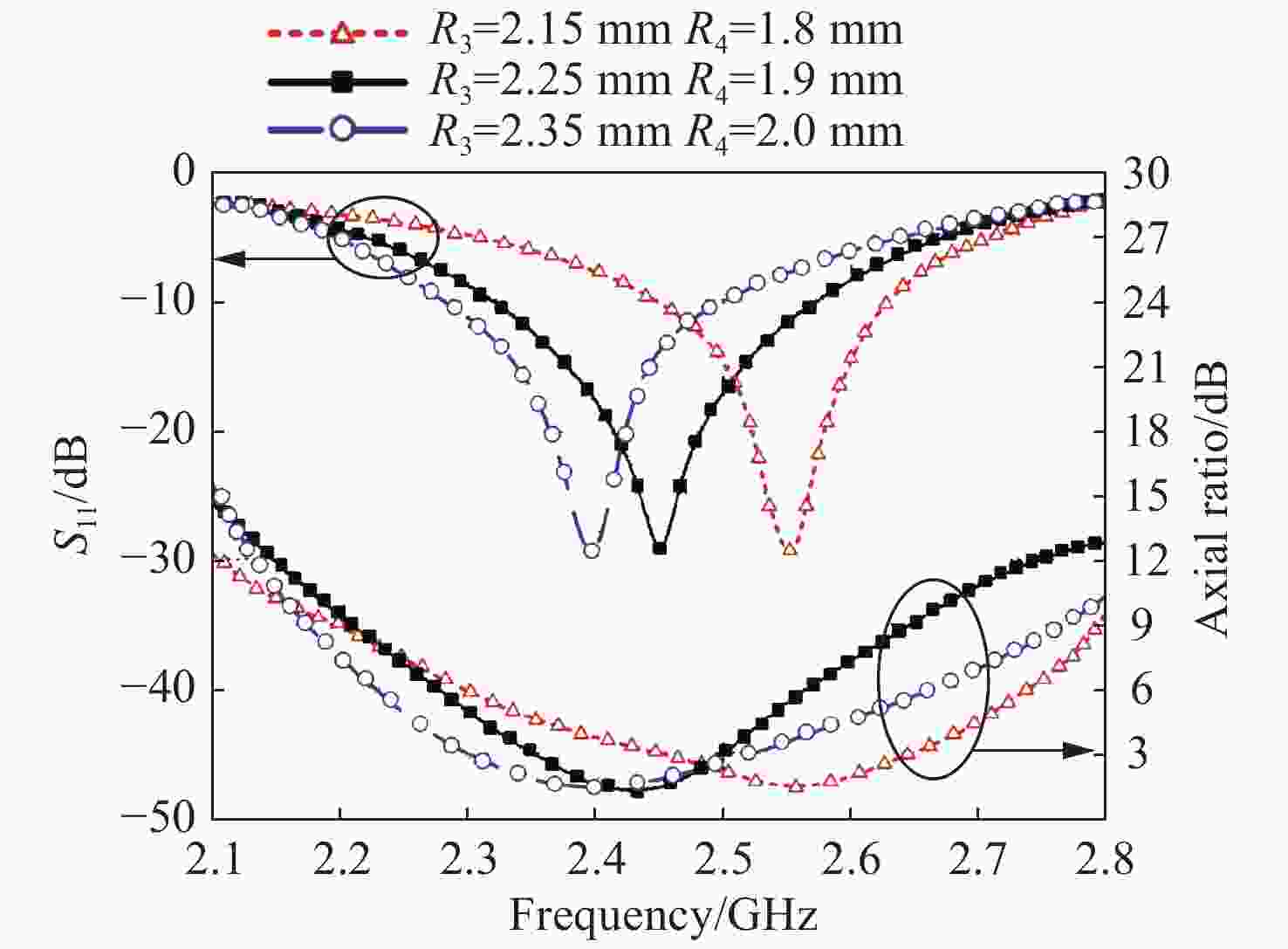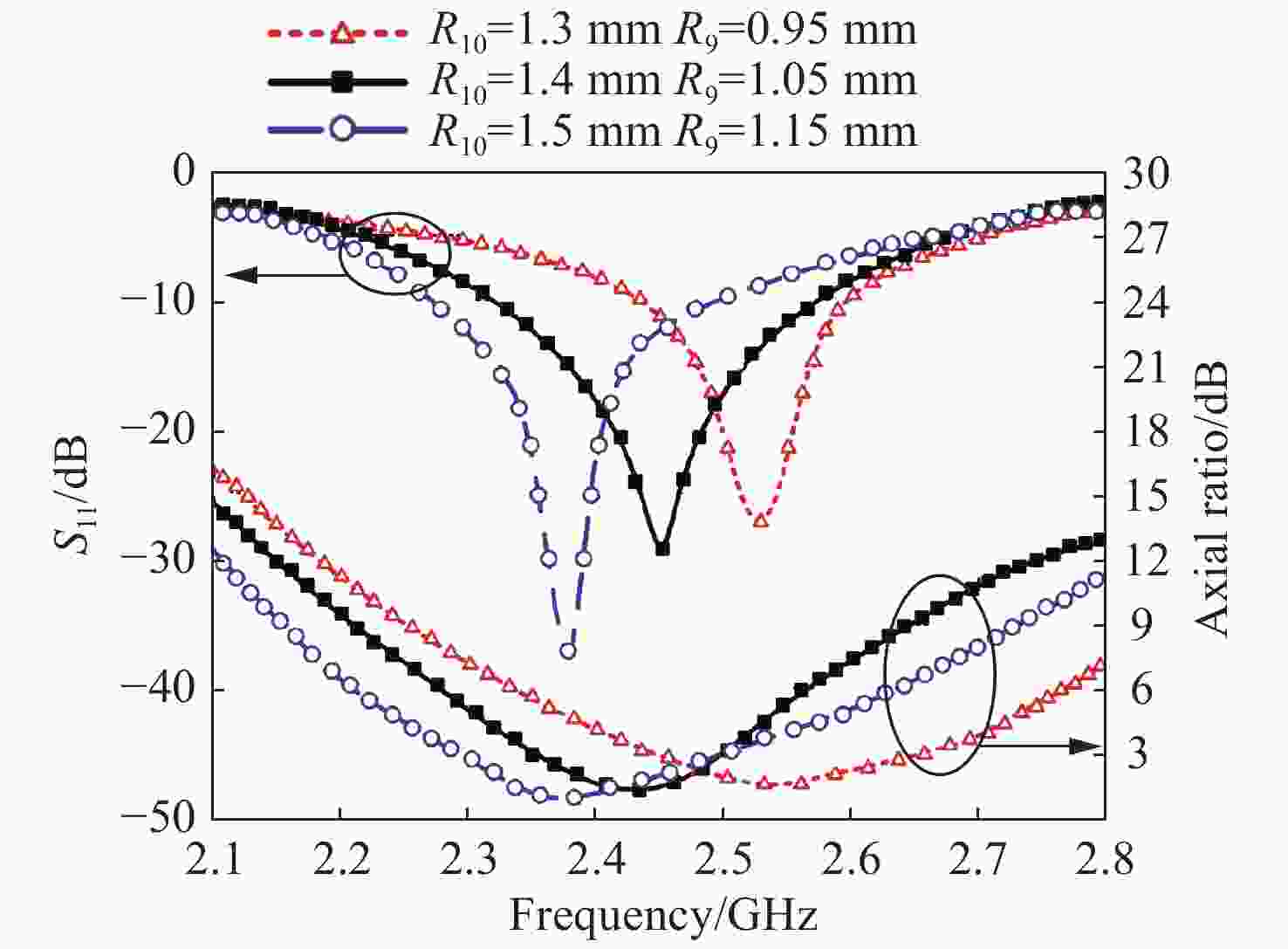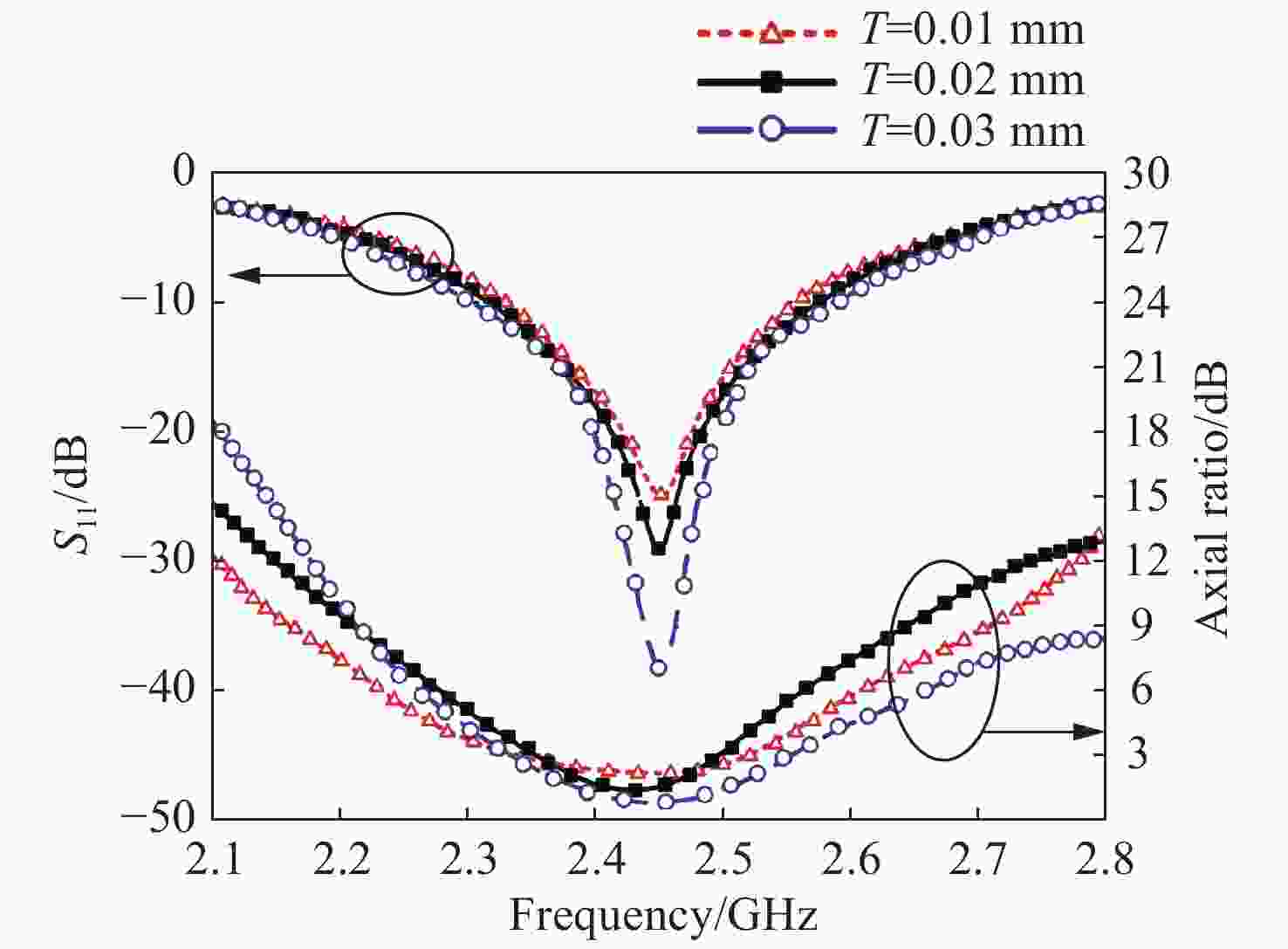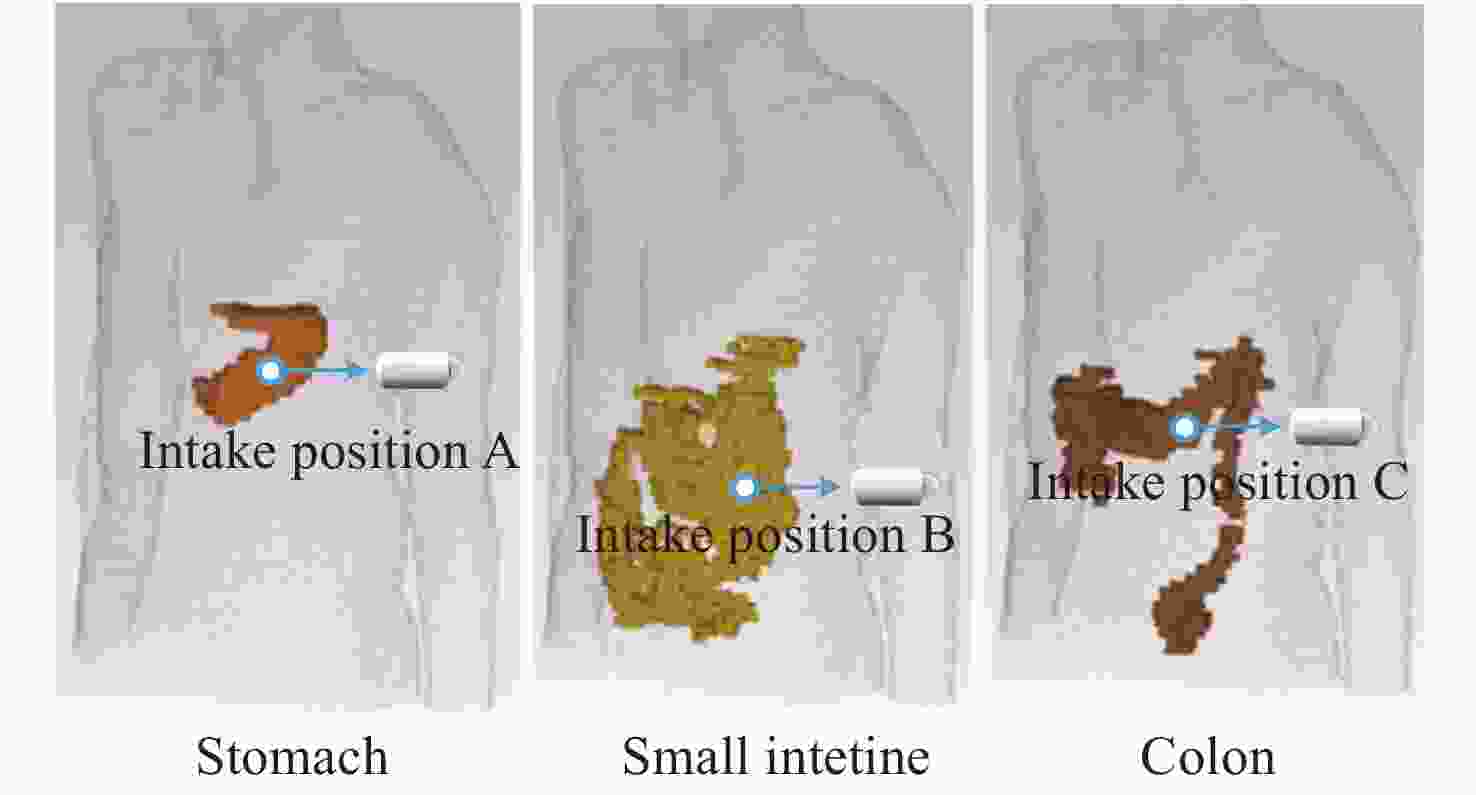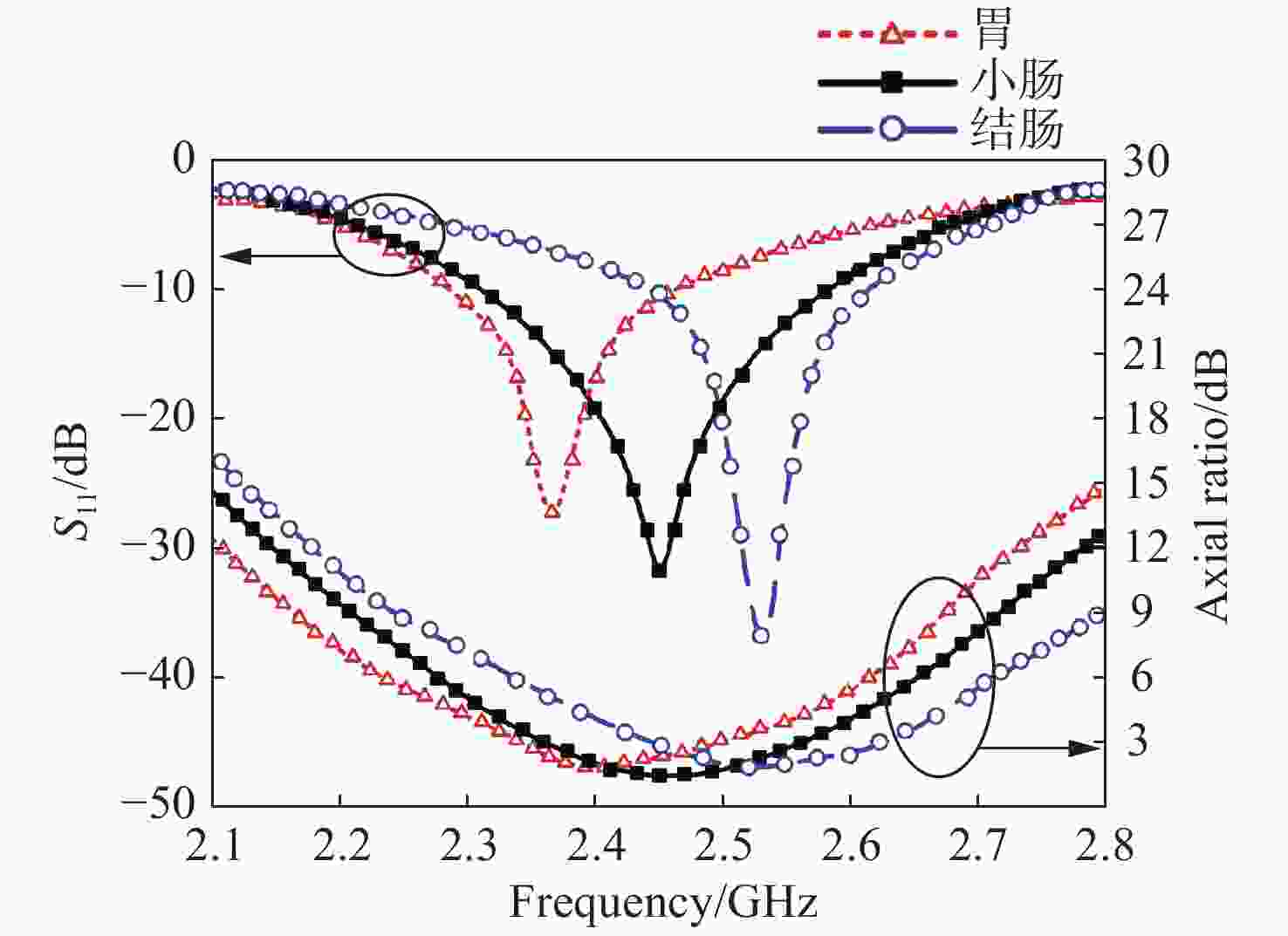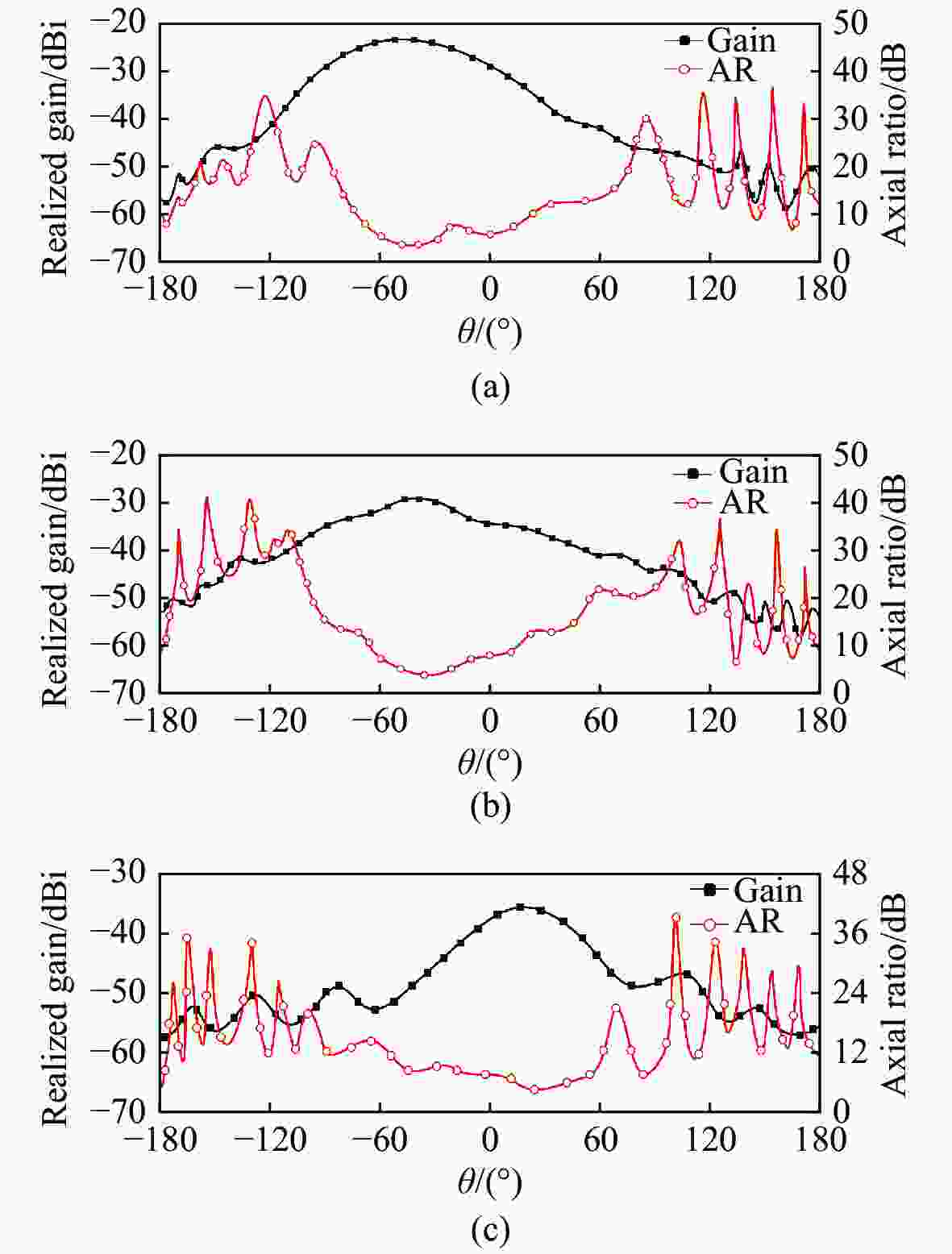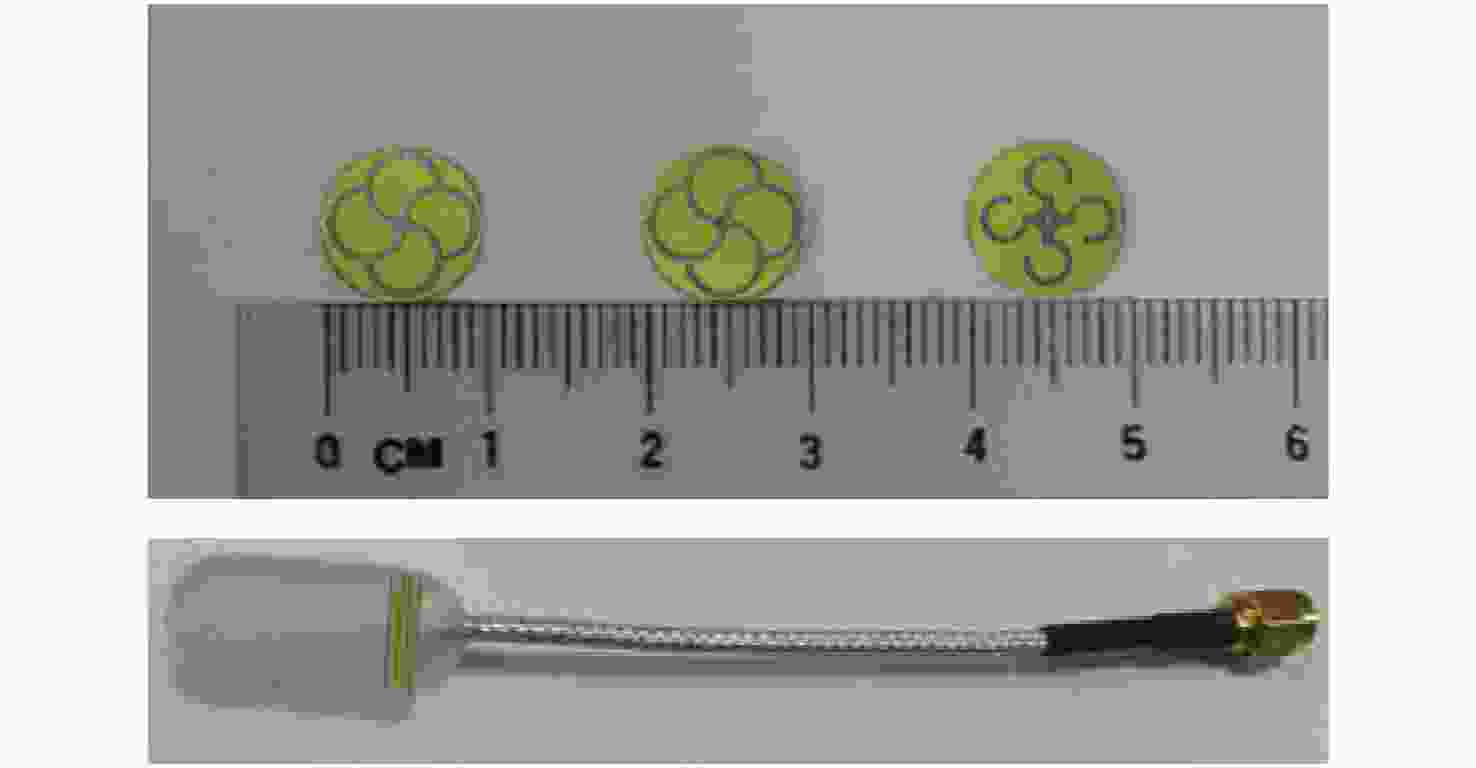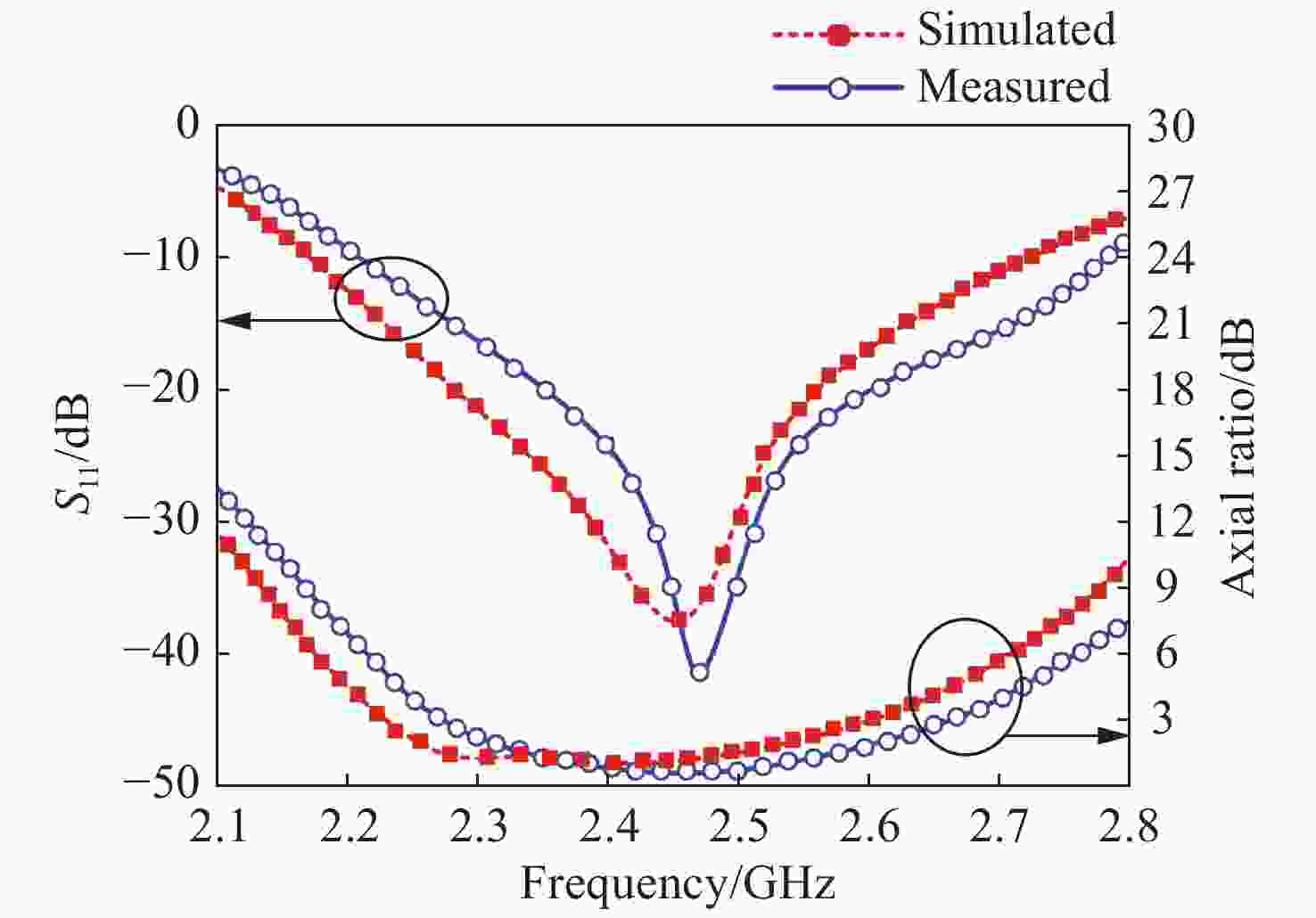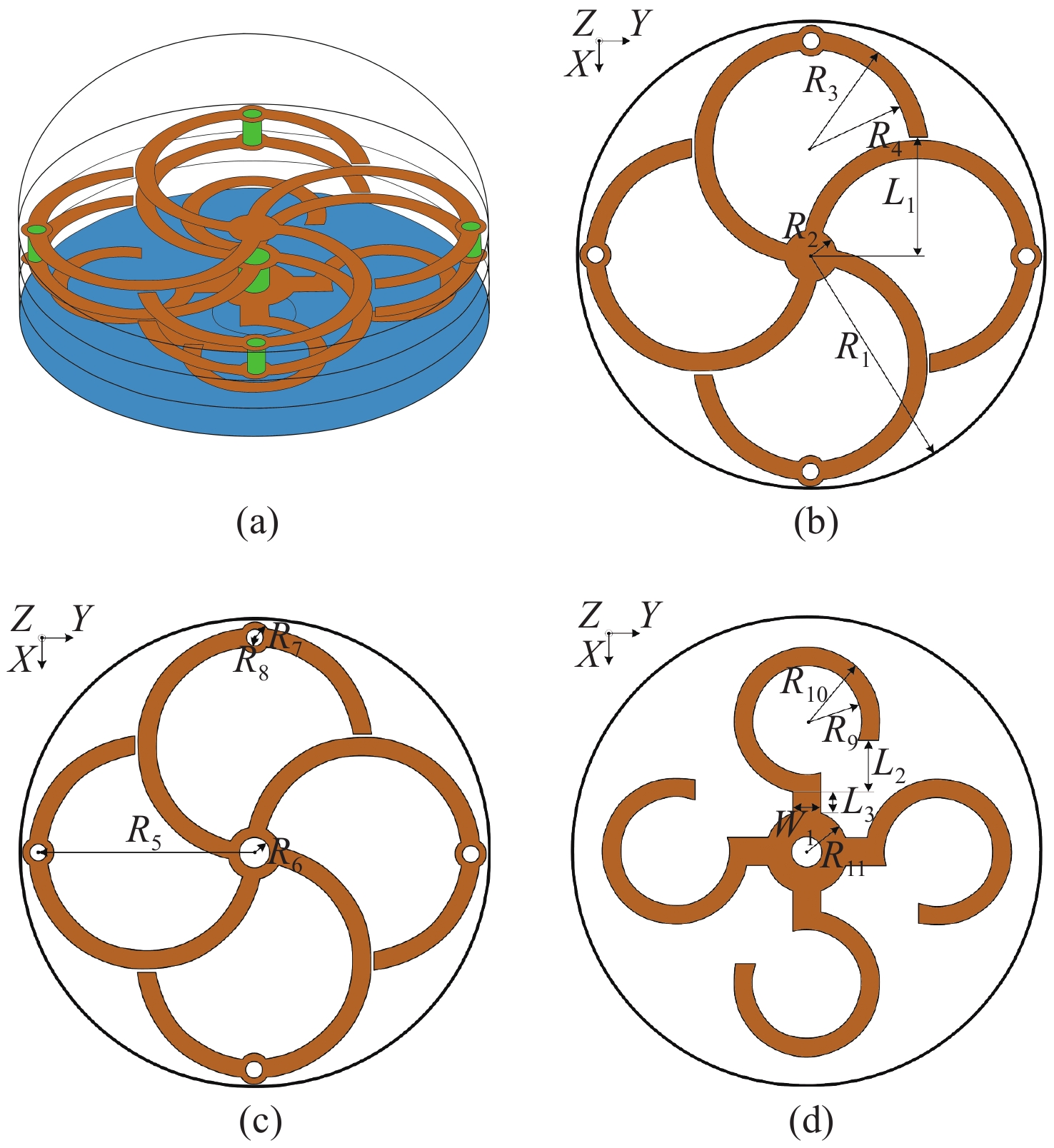Design of a graphene-based wide-band circular polarized antenna for capsule endoscopes
-
摘要: 为了提高胶囊内窥镜天线的工作性能,提高天线抗干扰能力和兼容性,进一步缩小尺寸,设计了一种基于石墨烯的用于胶囊内窥镜的宽频圆极化天线。该天线由3层辐射单元和地板构成,利用石墨烯薄膜优良的导电性能,制作天线的各层辐射单元和地板以有效增强胶囊天线的工作带宽与增益,提高传输效率并降低损耗。通过4个短路探针使第1层与第2层辐射单元相连接,构成复合螺旋天线,进而产生圆极化特性,既能减少误码率又能抑制多径干扰,并且能够更加高效地耦合电磁能量,有效改善阻抗匹配并调节圆极化纯度。详细分析了第1层、第2层和第3层辐射单元开口圆环尺寸、石墨烯薄膜厚度、天线摄入环境(胃、小肠、结肠等)对天线性能的影响。测试结果表明,设计的体积仅为π×4.52×1.905 mm3,阻抗带宽为2.2~2.78 GHz,轴比带宽为2.26~2.66 GHz,增益为−22.9 dBi,实际测量与仿真结果吻合良好,工作频段内辐射特性稳定,与现有技术相比,本文设计天线外形兼容性强,功能带宽更宽,具有宽频带、圆极化、抗干扰、电磁兼容性好、体积小等特点。该天线适用于ISM 2.4 GHz频段,能满足胶囊内窥镜摄入不同消化器官的工作要求。Abstract: In order to improve the performance of the capsule endoscope antenna and its anti-interference ability and compatibility, and further reduce its size, a graphene-based and wide-band circular polarized antenna for capsule endoscopes is designed. The antenna is composed of three layers of radiation units and a floor. By making use of the excellent electrical conductivity of multi-layer graphene film, the radiation units and the floor of each layer of the antenna can enhance the working bandwidth and gain of a capsule antenna, improve the transmission efficiency and effectively reduce the loss. Four short-circuit probes are used to connect the radiation units of first layer and second layer to form a composite spiral antenna, thus generating circular polarization characteristics, which can not only reduce bit error rate but also inhibit multipath interference. In addition, it can couple electromagnetic energy, improve impedance matching and adjust the purity of circular polarization. The effects of the size of the radiation units of first, second and third layers on the performance of the antenna, such as the size of the opening ring, the thickness of the multilayer graphene film, and the antenna intake environment of the stomach, small intestine and colon are analyzed in detail. The test results show that the antenna volume is only π×4.52×1.905 mm3, the impedance bandwidth is 2.2~2.78 GHz, the axial ratio bandwidth is 2.26~2.66 GHz, and the gain is −22.9 dBi. The actual measurement results agree well with the simulation results, and the radiation characteristics in the working frequency band are stable. Compared with the existing technology, this antenna is more compatible and its functional bandwidth is wider. The antenna has a wide band, circular polarization, good anti-interference, good electromagnetic compatibility and a small volume. The antenna is suitable for the ISM 2.4 GHz band, which can meet the working requirements of a capsule endoscope intake for different digestive organs.
-
Key words:
- capsule endoscope /
- wide band /
- circular polarization /
- graphene
-
表 1 天线的初始结构尺寸
Table 1. Initial structural parameters of the proposed antenna
参数 尺寸/mm 参数 尺寸/mm R1 4.5 R9 1.05 R2 0.8 R10 1.4 R3 2.25 R11 0.8 R4 1.9 L1 2.3 R5 2.08 L2 0.85 R6 0.3 L3 0.5 R7 0.3 W1 0.55 R8 0.2 -
[1] KAI S, TAKAHASHI M. The film antenna for capsular endoscope[J]. IEICE Communications Express, 2018, 7(7): 242-247. doi: 10.1587/comex.2018XBL0043 [2] 米智, 陈智辉, 杨毅彪, 等. 电介质球复合纳米天线对荧光定向发射的增强[J]. 中国光学,2020,13(1):121-130. doi: 10.3788/co.20201301.0121MI ZH, CHEN ZH H, YANG Y B, et al. Enhancement of directional luminescence emission by dielectric spheres hybrid nano-antenna[J]. Chinese Optics, 2020, 13(1): 121-130. (in Chinese) doi: 10.3788/co.20201301.0121 [3] CUI W J, LIU R P, WANG L, et al. Design of wideband implantable antenna for wireless capsule endoscope system[J]. IEEE Antennas and Wireless Propagation Letters, 2019, 18(12): 2706-2710. doi: 10.1109/LAWP.2019.2949630 [4] 王晓东, 颜伟, 李兆峰, 等. 平面天线在场效应晶体管太赫兹探测器中的应用[J]. 中国光学,2020,13(1):1-13. doi: 10.3788/co.20201301.0001WANG X D, YAN W, LI ZH F, et al. Application of planar antenna in field-effect transistor terahertz detectors[J]. Chinese Optics, 2020, 13(1): 1-13. (in Chinese) doi: 10.3788/co.20201301.0001 [5] 谷茜茜, 崔占刚, 亓波. 基于离轴自由曲面的激光通信光学天线设计[J]. 中国光学,2020,13(3):547-557.GU Q Q, CUI ZH G, QI B. Design of optical antenna for laser communication based on an off-axis freeform surface[J]. Chinese Optics, 2020, 13(3): 547-557. (in Chinese) [6] SUCHKOV D, GRANOV A, ANPILOGOV A, et al. Modeling of antenna system for capsule endoscopic complex “Landish”[J]. Procedia Computer Science, 2016, 88: 365-370. doi: 10.1016/j.procs.2016.07.450 [7] LIU CH R, ZHANG Y D, LIU X G. Circularly polarized implantable antenna for 915 MHz ISM-band far-field wireless power transmission[J]. IEEE Antennas and Wireless Propagation Letters, 2018, 17(3): 373-376. doi: 10.1109/LAWP.2018.2790418 [8] LI R Q, GUO Y X, ZHANG B, et al. A miniaturized circularly polarized implantable annular-ring antenna[J]. IEEE Antennas and Wireless Propagation Letters, 2017, 16: 2566-2569. doi: 10.1109/LAWP.2017.2734246 [9] BALABEL A A, MALHAT H A, ZAINUD-DEEN S H. Octafilar helical antenna for wireless in-body capsule endoscopy applications[J]. Journal of Advanced Research in Applied Mechanics, 2018, 44(1): 8-14. [10] MA SH B, SYDÄNHEIMO L, UKKONEN L, et al. Split-ring resonator antenna system with cortical implant and head-worn parts for effective far-field implant communications[J]. IEEE Antennas and Wireless Propagation Letters, 2018, 17(4): 710-713. doi: 10.1109/LAWP.2018.2812920 [11] YANG ZH J, ZHU L, XIAO SH Q. An implantable circularly polarized patch antenna design for pacemaker monitoring based on quality factor analysis[J]. IEEE Transactions on Antennas and Propagation, 2018, 66(10): 5180-5192. doi: 10.1109/TAP.2018.2862242 [12] YANG ZH J, ZHU L, XIAO SH Q. An implantable wideband circularly polarized microstrip patch antenna via two pairs of degenerate modes[J]. IEEE Access, 2019, 7: 4239-4247. doi: 10.1109/ACCESS.2018.2887234 [13] DAS R, YOO H. A wideband circularly polarized conformal endoscopic antenna system for high-speed data transfer[J]. IEEE Transactions on Antennas and Propagation, 2017, 65(6): 2816-2826. doi: 10.1109/TAP.2017.2694700 [14] LI ZH X, FAN Y, LIU X Y, et al.. A compact conformal dipole antenna with improved gain for wireless capsule endoscope systems[C]. 2019 International Conference on Microwave and Millimeter Wave Technology (ICMMT), IEEE, 2019: 1-3. [15] MIAH S, KHAN A N, ICHELN C, et al. Antenna system design for improved wireless capsule endoscope links at 433 MHz[J]. IEEE Transactions on Antennas and Propagation, 2019, 67(4): 2687-2699. doi: 10.1109/TAP.2019.2900389 [16] ARIFIN F, SAHA P K. Minimization of path loss for a UWB communication link in a wireless capsule endoscopy system using antenna parameters[C]. 2017 IEEE Region 10 Humanitarian Technology Conference (R10-HTC), IEEE, 2017: 765-768. [17] RAJAGOPALAN H, RAHMAT-SAMII Y. Wireless medical telemetry characterization for ingestible capsule antenna designs[J]. IEEE Antennas and Wireless Propagation Letters, 2012, 11: 1679-1682. doi: 10.1109/LAWP.2013.2238502 [18] JIANG Y N, YUAN R, GAO X, et al. An ultra-wideband pattern reconfigurable antenna based on graphene coating[J]. Chinese Physics B, 2016, 25(11): 118402. doi: 10.1088/1674-1056/25/11/118402 [19] TANG D L, WANG Q L, WANG ZH, et al. Highly sensitive wearable sensor based on a flexible multi-layer graphene film antenna[J]. Science Bulletin, 2018, 63(9): 574-579. doi: 10.1016/j.scib.2018.03.014 [20] BALANIS C A. Antenna Theory: Analysis and Design[M]. 3rd ed. Hoboken, NJ: John Wiley, 2005: 568. [21] SONG R G, WANG Q L, MAO B Y, et al. Flexible graphite films with high conductivity for radio-frequency antennas[J]. Carbon, 2018, 130: 164-169. doi: 10.1016/j.carbon.2018.01.019 -






 下载:
下载:
